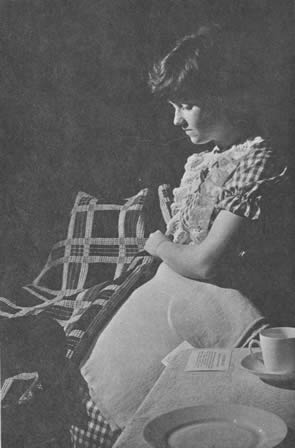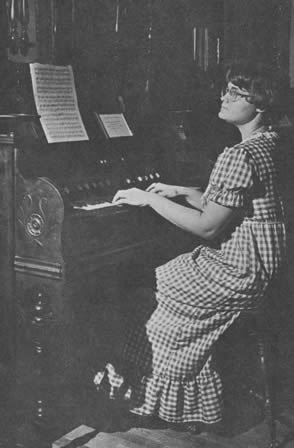Volume 4, Number 9 - Fall 1972
The Summer Meeting
From the Springfield, Mo. Leader & Press & The Springfield Daily News
Mon., June 19, 1972
The illustrated story of pioneer milling in the Ozarks is being created at the School of the Ozarks, members of the White River Valley Historical Society learned in their quarterly meeting there yesterday.
Along with the construction of an authentic Ozarks water mill on the campus, there is being created a museum of milling and a hall of fame to credit persons who contributed to this important area industry. Hope is the mill will be grinding grain by September.
Following a dinner meeting and program Sunday at the Friendship House, the historians were taken on a tour of the structure. It will be known as the Edwards Mill in honor of Hubert and Alice Edwards of Kansas City. The couple underwrote the cost of the
[5]
building and operation of the mill, which will be conducted as a student involvement from the growing of the corn, through its milling and marketing.
The museum will be an extension of the Ralph D. Foster Museum, of which Steve Miller is director. Bill Cameron, expert on milling equipment, and his late wife, Mrs. Letha Britain Cameron, originated the idea of building a water mill below the lake on the campus, but the project has become far larger and more impressive than they at first envisioned. Cameron is working closely with the School in assembling information about pioneer water mills of the area and a memorial in the mill will honor Mrs. Cameron.
Harding Wyman is supervisor of the painstaking work on the building, in which he has had student cooperation. Drawings by Miller served as a design concept for the mill. Lumber suitable to the pioneer period, huge wrought metal hinges, and other authentic touches give interest to the building. An amazing number of old millstones have been assembled. One of these reportedly was used in grinding at an early-day water mill on the Jordan in Springfield.
Mrs. Vance Randolph, recently retired folklore teacher at the University of Arkansas and wife of the famous Ozarks folklore writer, was the scheduled speaker. However, Mrs. Jewel Rose Mehus, editor of the Historical Society Quarterly and program chairman, reported Mrs. Randolph suffered a broken foot Saturday. Only a few days prior to that Randolph fell and broke a hip, his second such injury. Their retirement home has been in Rogers, Ark.
Steve Miller on short notice took over as speaker, showing slides to point up his belief that there has been "one of the greatest revolutions of all times" in people’s attitude toward relics of the past. Items of earlier days "from Aunt Bessie’s bitter bottles to Aunt Mary’s quilt patterns" all at once have been rescued from cobwebs of the attic to be honored as things of beauty and value," he noted.
"1 see this all the time in the attitude of people who visit the museum," he said.
Slides of museum exhibits showed a rolltop desk used by General Grant; a collection of cameos he called "one of the finest in the world;" stage props used by the famous Ozarks vaudeville act, the Weaver Brothers and Elviry; a rare collection of coins and paper money; a country store complete with cracker barrel, a pioneer drug store with furnishings contributed by Foster and Dan L. Leyerle of Springfield, and many other things.
In an "Ozarks Hall of Fame" Miller listed as great contributors to the new appreciation for the Ozarks heritage Randolph, Harold Bell Wright, May Kennedy McCord, Rose O’Neill, Mary Elizabeth Mahnkey, Thomas Hart Benton, and Foster.
Miller revealed another of his dreams will soon be realized. An expansion of the museum will include a little one-room schoolhouse from the banks of Flat Creek near Cassville. It is the gift of Mr. and Mrs. Donald Sater and will be moved out to the Campus. The gift was of special interest to at least one of the society members, Emory Melton, Cassville attorney and newspaper publisher, who once was a young pupil in the school.
Dr. O. Myking Mehus gave the report of the nominating committee, which also included Mrs. Margaret Christopher and Mrs. Lucile Anderson. Officers were re-elected including Mrs. Ruby M. Robins, Gainesville, president; Mrs. Cinita Brown, Ava, first vice-president; Mrs. Hariet H. Massey, Ozark, second vice-president; Albert D. Cummings, Point Lookout, secretary-treasurer; and Elmo Ingenthron, Kirbyville, historian.
Re-elected to two-year terms on the board of directors were Mrs. Stella Luna, Gainsville; Mrs. Helen Fletcher, Branson; and Mrs. L.D. Burns, Yellville, Ark.
From The Springfield News and Leader
Mon., June 19, 1972
The United States is in a period of nostalgia and this includes interest in almost every old item of the Ozarks, Steve Miller told members of the White River Historical Society here Sunday.
The artist-in-resident at the School of the Ozarks and the director of its Ralph Foster museum spoke to the group Sunday afternoon at the Friendship House. Miller was a substitute speaker for Mrs. Vance Randolph, who could not fulfill a speaking engagement because of a recent injury.
"Some of the people who visit our museum seem to be almost out of their minds in their interst for old things," Miller told his audience of about 50 members.
[6]
 |
 |
|
| Pioneer craftworks have an individual ingredient of loving care not found in modern assembly-line things. Debbie Kean of the Foster Museum student staff holds a 100 year old coverlet and linsey blanket, dyed, spun and loomed by Katherine Hillhouse. Contributed by Mrs. A. E. Seymour and Ruth Clark. | Museum staff member, Jeane Myer, at keyboard of the Cornish parlor organ. Contributed by Mr. Ralph Foster, and Mrs. Bertha Youngblood, in loving memory of William V. and Pauline A. Holbrook. |
"All at once Aunt Bessie’s bitters bottle and Aunt Harriet’s quilt patterns are things of great beauty. Now all of us here knew this but now the young people are discovering this."
Miller praised a small group of Ozarkers who he said had the foresight to hold tight to the Ozarks culture long before it became fashionable.
"Vance Randolph is called the greatest living authority on the Ozarks and is so recognized throughout the world." Miller said. "And we are still revolving around Harold Bell Wright and his aura of nostalgia and his importance to history."
Also praised by Miller as great Ozarkers were May Kennedy McCord, Rose O’Neill, Mary Elizabeth Mahnkey, Thomas Hart Benton, and Ralph Foster. He showed the society members a black and white drawing of the reconstructed Edward’s Mill recently relocated on the college campus.
"This is an outgrowth of an idea," he said of the drawing. "All my life as an illustrator of books and other things I have been searching for a medium to illustrate Ozarks subjects. We always had black and white scratchboard drawings but they were always so delicate that they couldn’t get the ruggedness that is characteristic of the Ozarks."
Miller said in an interview later he and his student associates took a three-quarter inch plywood sheet and poured a special liquid chalk three-eighths of an inch thick on top of the plywood. They then coated it with a special black and left it to harden.
The drawing of the Edward’s Mill was then made using chisels, sandpaper and steel wool.
"It is drawing with a whole new set of tools, and it has brought out new possibilities. We had some blind people come in from St. Louis and they could feel the drawing. One said, ‘I can read Braille but this is the first drawing I ever felt."
[7]
In praising our Ozark Heritage, Miller went from prehistoric Ozarks Bluffdwellers to Springfield’s Weaver Brothers and Elviry who Miller said had been world famous and were the developers of today’s country-western music formula.
One item Miller said he misses is a good taste of old time coffee ground at the store or at home.
While not praising old time Ozarks medical practices Miller said he is not sure some parts of it might now return.
"Some of you may remember when you could go into an Ozarks drugstore and buy a live leech to remove some blood if it was bad or if you had high blood pressure. What we didn’t know was that the secondary infection was probably claiming a lot of people. But I am expecting any day for some doctor to come forth and say that was the way to do it, so leeches may come again.
[8]
This volume: Next Article | Table of Contents | Other Issues
Other Volumes | Keyword Search | White River Valley Quarterly Home | Local History Home
Copyright © White River Valley Historical Quarterly

